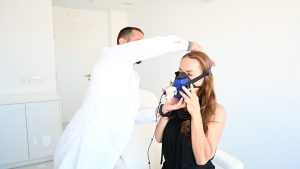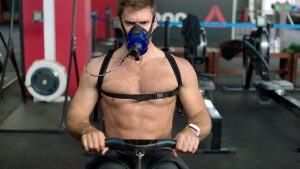FUEL. TRAIN. PERFORM.
PNOE Measures your Movement Economy – The mother of all endurance metrics
All of us athletes are obsessed with the term “movement economy,” and with good reason. But what does it mean? And how does it impact our performance?
economy,” and with good reason. But what does it mean? And how does it impact our performance?
Movement economy has to do with the amount of energy (i.e., calories) your body burns during exercise. By measuring mechanical (i.e., watts for cycling, pace for running) and chemical (i.e., the calories you release by burning fats and carbohydrates) power simultaneously, we can accurately measure movement economy and determine the exercise intensity where your body works most efficiently.
A higher movement economy means your body burns fewer calories for a given level of exercise intensity (e.g., biking at 220 watts or running at six mph) and therefore requires less energy intake (i.e., supplementation of carbohydrates) and accumulates less fatigue. Developing and maintaining a high movement economy is perhaps the most essential physiological attribute for every endurance athlete.
The training intensity where you maximize your movement economy can vary vastly from one person to another. Therefore, it’s paramount to accurately measure your body’s movement economy profile in different exercise intensities to determine where you should train and race.
The PNOE metabolic analyzer provides gold-standard accuracy in determining your movement economy along with the training and nutrition plan your biology needs to optimize it. The PNOĒ test takes about 10 minutes to complete, and all it requires is a short bout of exercise while wearing the PNOĒ mask, which collects and analyzes your breath.
Contact us to schedule your PNOĒ test now! 
Finding your limiting factor and the plan to overcome it.
We have a lot of athletes, whether professional or recreational, who are looking to beat their last time, get ready for their next triathlon, or run their first marathon ever. All of them come to us asking the same question- how can I train better?
They’ve dedicated the time, but they just can’t seem to beat their last time. The reality is that our body is made of different systems that work well together to achieve peak performance.
Therefore, the secret to improving performance is identifying your limiting factor and the plan to overcome it.
Your ability to move and perform depends almost exclusively on how you use oxygen to burn macronutrients (i.e.. fats, carbs), release the energy required (i.e., calories), and subsequently clear the carbon dioxide produce that we measure during your PNOE Metabolic Test.
This process is supported by four systems in your body: Heart, lungs, bloodstream, and cells. First, our lungs absorb the oxygen from the air we inhale, which then enters the bloodstream. Oxygen-rich blood is then pumped through our heart to our body where it’s absorbed by our cells, which use it to burn nutrients and release the energy they contain (i.e., calories). 
Achieving any fitness goal, from dropping a few pounds to completing a triathlon, depends on the effective operation of these four systems.
For each of us, at any given point in time, one or more of these four systems may be limiting oxygen transport and, therefore, our performance. For example, a common limitation for bikers, swimmers, and runners is found in the lungs and it’s manifested when they over-breathe or breathe shallowly. Finding your limiting factor is the single most effective method for achieving better performance with the least possible effort and risk of injury.
The PNOĒ test offers the gold standard for measuring oxygen flow throughout your body and identifying your limiting factor. However, it goes beyond just finding the problem. It also identifies the optimal combination of breathwork, cardio, interval, and strength training that will cause the necessary metabolic adaptations to overcome your limitations and achieve optimal performance.
The PNOĒ test takes about 10 minutes to complete, and all it requires is a short bout of exercise while wearing the PNOĒ mask, which collects and analyzes your breath.
